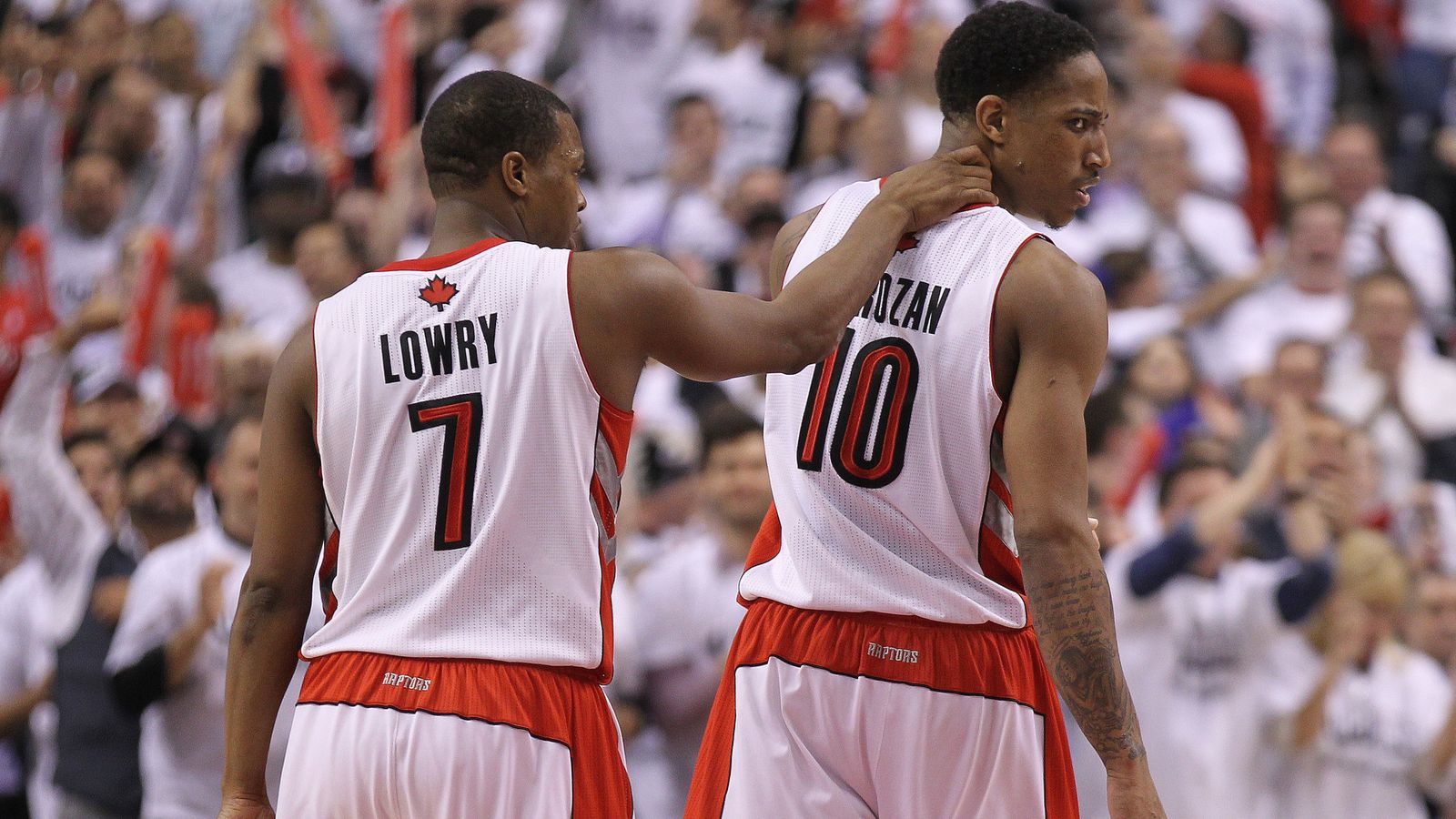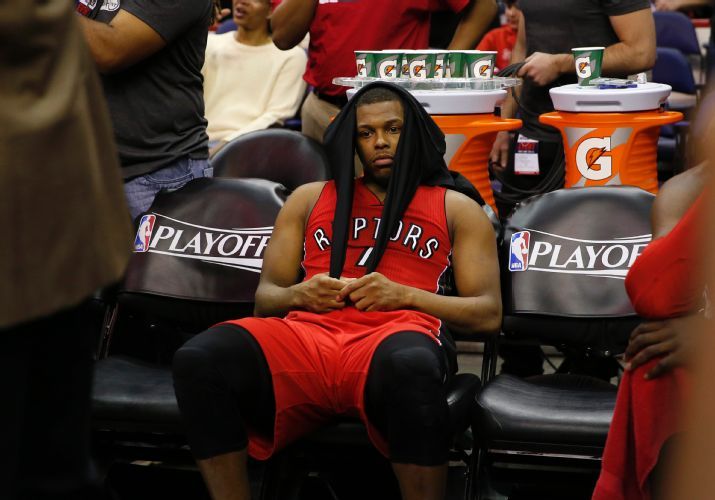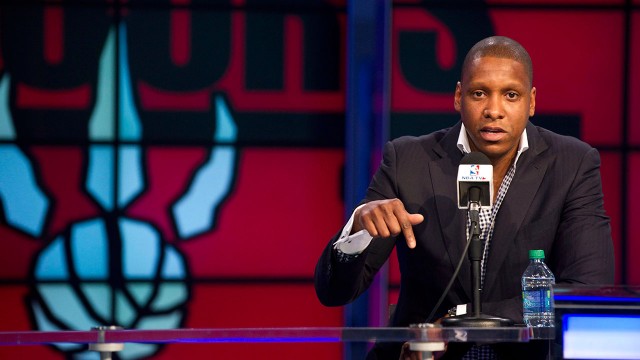The writing is painted on the wall, printed in bright Raptors red. Change is coming.
But before general manager Masai Ujiri takes the torch to his partially-inherited roster, he has to answer one question: who are the Raptors?
It’s clear that there are two Raptors teams. There is the 2014 Raptors, the happy accident, the tankjob gone oh-so-right. Something clicked after the Rudy Gay trade and it led to two half seasons of beautiful, scrappy, team-oriented basketball. That club went 58-27 and posted a strong net rating, fuelled by a healthy offensive rating and a passable defensive mark.
When discussing the Raptors, keep these splits in mind. pic.twitter.com/PLsW3DRARW
— Raptors Republic (@raptorsrepublic) April 27, 2015
Then there is the 2015 Raptors, the black sheep that sparked rage and frustration for not living up to the 2014 rendition. The offense remained robust on paper, posting an even stronger offensive rating, but the system became more skewed, more reliant on isolation-type sets and less conducive to defense, something Dwane Casey discussed at his year-end presser.
Even though you’re winning, to me, my one area, what I didn’t do a good job of, was establishing an offensive style. Now that sounds crazy, we were in the top-10 in offensive efficiency. But establishing a style of play offensive that will help out defense.
…
I thought a lot of our defensive woes was connected directly to our shot selection, our quick shots. Make or miss, you’ve got to establish a style of play that will help get you back on defense.
Casey is on-point about the Raptors’ poor offensive sets leading to shoddy defensive possessions. Isolations, by definition, are borne from chaos and randomness. There’s no flow to an isolation. In turn, that makes it hard for the players without the ball to instively understand when to get back on defense, and where to position themselves to get back on defense. With an isolation, the team is guessing where to go at the same time as their opponents and the Raptors don’t hold an athletic advantage over most teams. It also didn’t help that so many of the Raptors’ shots came from the perimeter. It doesn’t take a thorough understanding of Newtonian physics to understand that longer shots lead to longer rebounds.
But that’s not to excuse the system, which didn’t do the players any favors. The Raptors didn’t have the type of athletes to run the hyper-aggressive schemes that Casey called and it was apparent to just about everybody — Casey included — that it wasn’t working. I wrote a breakdown of their defense in mid-January. By that point, any misunderstandings or coincidental happenstances were pretty much out the window: their defense ranked 22nd and it went on to finish 25th, before getting torn to shreds by Washington.
Either way, the 2015 Raptors were not good, whereas the 2014 Raptors were. Can the Raptors get back to that level? Or is this the new reality?
There’s also the difference in franchise outlook. In 2014, their prospects in Jonas Valanciunas and Terrence Ross were both a year younger and a world’s apart in perceived potential.
It’s hard to remember, but Ross was actually an okay defender with a beautiful 3-point shot last season. Everyone remembers the 51-point game where he rained jumpers on the Clippers, but the game that always stuck out to me was the Pacers game where Ross shut down Paul George. That isn’t hyperbole on my part. He actually shut down Paul freaking George.
In retrospect, that Ross seems like an entirely different person. Ever since last year’s playoffs, Ross has been nothing but an unreliable and frustrating enigma. He even lost his starting spot to James Johnson, before he reclaimed the spot out of necessity (Johnson and DeRozan on the wing left no spacing for the offense). Ross was given every opportunity to shine, but his defense remained poor — with the instincts of a rookie — and he was invisible once more in the playoffs.
There was also much more hope for Valanciunas. He is still seen a tremendous prospect by many (I don’t include myself) but coming into last season, the school of thought on Valanciunas was still, firmly, that he was to be the future of the team. He gained immunity after fans steeled themselves for an impending tank that never came. To this day, that same immunity still protects him in the eyes of many.
But it’s not the same Valanciunas. He got slightly better in 2015, but it wasn’t the garantuan leap many expected. Instead, he has lost ground to inflation. While it’s promising that his rim-protection and post-scoring improved, it’s equally – if not more – damning that he remains a full beat and a half slow on both sides of the court. He’s an awkward fit in an era of fluid motion-based offenses and an immobile statue ill-fit for the trends of defensive versatility and mobility.
The key with Ross and Valanciunas is their future. For the time being, they’re fringe starters with rather glaring weaknesses. But what upside do they have? What are their chances of approaching that upside? Can the Raptors rely on their growth as a source of talent influx?
To take stock: the 2014 Raptors were a legitimately good team with promise. They had productive role players and enough promise between Ross and Valanciunas to stay the course. In contrast, the 2015 Raptors are a bungled mess, where offense is uncreative, defense is inept, potential is stagnant and chemistry (look no further than the whole Casey-Lowry spat) is absent. In short, there’s reason to build on 2014 and there’s reason to tear down 2015.
But there’s a fascinating co-variate to all this, that being the play of Kyle Lowry.
When I say that Kyle Lowry was a superstar for the Raptors in 2014, I mean it whole-heartedly with no hint of bias. He really was the reason why the Raptors enjoyed so much success in 2014. He was a potent scorer, a lethal shooter, a creative attacker, a stingy defender and a full-hearted gritty player that played his heart out regardless of circumstance or perceived status. He sparked the team whenever they needed and he made everyone around him better. On his best days, Lowry went toe-to-toe with the likes of Russell Westbrook and Chris Paul. It was Kyle Lowry Over Everything and it was glorious.
But superstar Lowry was nowhere to be found in 2015. He never showed up. He was never the same after needing to shoulder the entire load after DeRozan’s injury. His numbers dipped across the board and he slipped from being a legitimate All-Star Game starter (and possible All-NBA guard) to a below-average, slow, ineffective volume gambler. The trickle-down effect poisoned every aspect of the team. Without a star to guide them, the Raptors lost their way.
It’s no coincidence that the Raptors came as he went. That’s the effect stars have on NBA franchises. When they’re playing like a star, everyone around them gets better. It empowers the role players to work harder, to perform better. They attract defensive attention and open up looks for spot-up shooters. The true stars play like leaders and it corrals players to follow their lead.
When Lowry was playing like a star, the Raptors were good. When he wasn’t, like in 2015, the Raptors were a middling team. For all the talk of chemistry, schemes, coaching motivations and rotations, it might have actually been that simple: maybe the Raptors are only good when Kyle Lowry is playing like a star. I got that frome one of Eric Koreen’s Twitter musings back in February (I couldn’t find the exact tweet, sorry Eric).
If that is true, it supposes yet another question: should you build on Kyle Lowry? And accordingly, can Lowry sustain star-level production without breaking down? I don’t have the answer. But history tells us it’s not likely. Lowry had a career-best calendar year in 2014 and sustained a level of health, productivity and maturity he had never previously exhibited.
All these questions circle back to the central question of, “who are the Raptors?” There are so many intricate and overlapping components and the answer isn’t clear. But that’s the task that befalls Ujiri and his staff for the coming offseason.
Coming into the playoffs, Ujiri stated that the outcome of the postseason will affect “everything.” If that is to be the case, then there’s a very good argument to be made for tearing this team down to the bone and starting over.
Masai, last week: "Playoffs make an impact in terms of evaluating for the offseason. 100% it influences everything". Should be a busy summer
— Josh Lewenberg (@JLew1050) April 26, 2015
So who are the Raptors? Can they get back to their 2014 level or is 2015 here to stay? Are the prospects in Ross and Valanciunas good enough to build upon? Can Lowry sustain star-level production?
If the answer is that the Raptors are still the same up-and-coming team that Ujiri stumbled upon last season, then he should stay the course. He should bring in some complementary pieces to surround the core of DeRozan, Lowry and Valanciunas. He has enough cap space to play with and he has done a good job of stockpiling assets to grease the wheels for a trade if need be. With better health, a dash of development and a few key additions (notably, on the wings and in the frontcourt), the Raptors could be a viable pseudo-contender with upward mobility in 2016 (rising cap, the Knicks pick).
But if the answer is no — if 2015 is the new reality, if Lowry can’t sustain the workload, if Valanciunas and Ross are stagnant prospects with limited upside — then major changes must be on the way. There’s no way around it. They need more talent, a better system to maximize the talent and a true star to lead the team.
We’ll see what Ujiri decides about this team. In the words of the global ambassador, “know yourself, know your worth.” His actions will to speak much louder than his words this summer.







